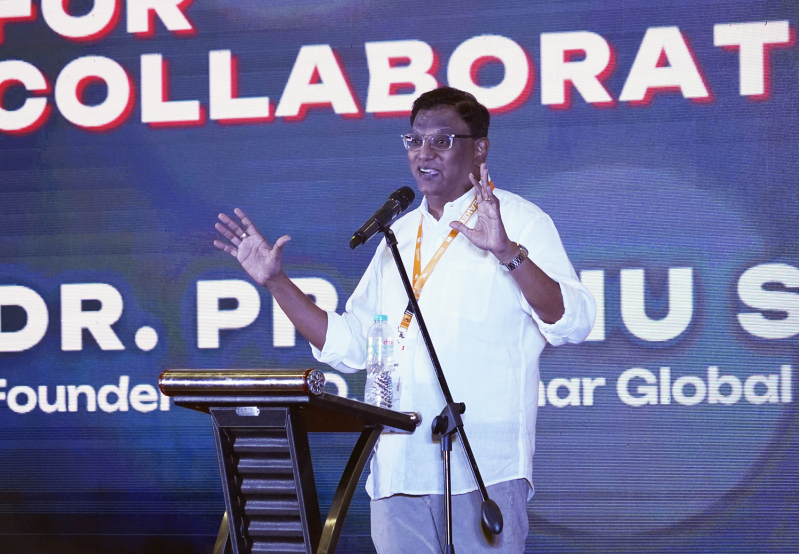
The third day of the Arise Leadership Summit 2025 opened with a message from Dr. Prabhu Singh, Founder and CEO of the Issachar Global Education Network (IGEN), who urged participants to prioritize collaboration in global mission work, drawing on lessons from the early Church in Antioch as recorded in Acts 11.
Addressing an audience of younger and more seasoned Christian leaders from across Asia and beyond, Singh called for what he termed “missional synergy,” highlighting the importance of cooperation between theological educators, mission agencies, and different generations within the church.
Singh categorized early Church contributors in Antioch into three types: missional innovators who first shared the gospel with Gentiles; missional influencers such as Barnabas, who affirmed and encouraged the new believers; and missional instructors such as Saul, who provided sustained teaching. He said these roles offer a model for collaboration today.
“The gospel spread in Antioch through people whose names we don’t know,” Singh said. “But their obedience and cooperation resulted in a significant advance for the mission of the Church.”
Division and collaboration
Singh warned that persecution, corruption, and division remain recurring threats to Christian mission, referencing internal splits over strategy within global missional bodies. He shared an example from a past consultation in Istanbul, where divisions over the “Insider Movement” hindered cooperation among leaders working in the same context.
“It is often easier to embrace the unfamiliar outsider than to reconcile with a familiar colleague,” Singh said. “But Acts 11 shows the importance of collaboration across differences.”
He cited the famine relief effort described at the end of the passage, where the Antioch church sent resources to believers in Judea, as a further example of practical collaboration between church communities.
Cultural relevance in gospel communication
Singh also addressed the need for contextual gospel communication. Referring to the evangelists in Acts 11, he noted that they presented Jesus not as “Christ” (a title more familiar to Jews), but as “Lord,” a term more accessible to the Gentile audience in Antioch.
“This approach reflects an intentional effort to communicate the gospel within the cultural framework of the hearers,” Singh said. “The gospel is supercultural in origin, transcultural in application, and incultural in delivery.”
He cautioned against presenting Christianity in ways that obscure the message of Jesus through unnecessary cultural forms or expectations.
“People may be open to Christ but turned away by the way we present him,” he said.
Generational focus and institutional gaps
Singh emphasized the importance of engaging Gen Z with both clarity and respect, calling them a generation “to be understood, not just reached.” He noted that younger believers often bring new perspectives and approaches that need to be integrated into broader mission strategies.
He also addressed disconnects between theological institutions and mission agencies, particularly in the Global South. As an example, he described efforts in one Asian country to bring together leaders of theological seminaries and national mission organizations. He said there are numerous theology students currently in training, while many mission groups continue to report shortages in workers.
“These two sectors often operate in isolation,” Singh said. “But bringing them into dialogue could significantly strengthen long-term mission efforts.”
Call to sacrificial commitment
In closing, Singh referenced the cost borne by early Christians in Acts 11, who continued to proclaim the gospel despite being displaced by persecution.
“The good news led to bad news for them—they lost jobs, homes, businesses,” he said. “But they kept proclaiming.”
To illustrate the ongoing relevance of sacrificial commitment, Singh shared a story recorded by mission historian Samuel Hugh Moffett about the Karen church in Myanmar. Years after many Karens had come to faith through the ministry of Adoniram Judson, the community faced a devastating famine. Their fields were overrun by rats, and with no other food available, they resorted to catching and eating the rodents to survive.
Despite their circumstances, when the Karen believers heard that missionaries were planning to conduct outreach among the nearby Kayin people, they approached the foreign mission leaders and offered a financial contribution. The missionaries, aware of their extreme poverty, declined at first. But the Karen elder insisted, placing the money into the missionary’s hand.
“Yes, we eat rats,” the elder said. “But the Kayins cannot live without the gospel.”
Singh said this story exemplifies the spirit of mission that the Church must recover.
“The history of Christianity in Asia is filled with stories of believers who gave sacrificially, not out of abundance, but out of gospel conviction,” Singh said. “This is the kind of heart the Church must embrace again—where the gospel is worth everything, even when we have almost nothing.”





